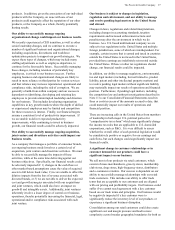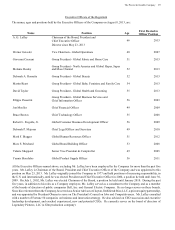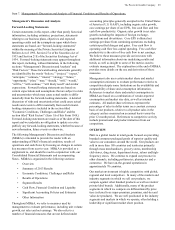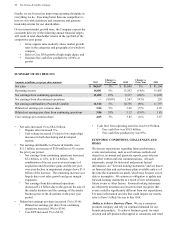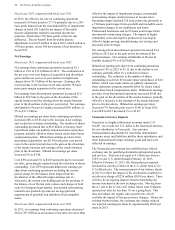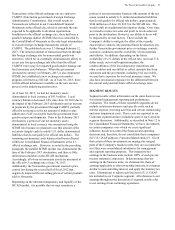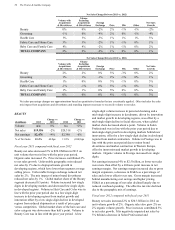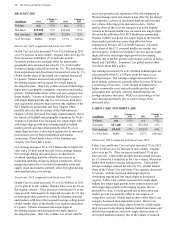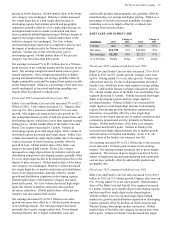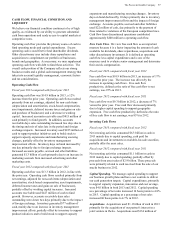Proctor and Gamble 2013 Annual Report Download - page 29
Download and view the complete annual report
Please find page 29 of the 2013 Proctor and Gamble annual report below. You can navigate through the pages in the report by either clicking on the pages listed below, or by using the keyword search tool below to find specific information within the annual report.The Procter & Gamble Company 27
trade customers. Our continued success is dependent on
leading-edge innovation with respect to both products and
operations, on the continued positive reputations of our
brands and our ability to successfully maintain trademark
protection. This means we must be able to obtain patents
and trademarks, and respond to technological advances and
patents granted to competition. Our success is also
dependent on effective sales, advertising and marketing
programs. Our ability to innovate and execute in these areas
will determine the extent to which we are able to grow
existing net sales and volume profitably, especially with
respect to the product categories and geographic markets
(including developing markets) in which we have chosen to
focus. There are high levels of competitive activity in the
environments in which we operate. To address these
challenges, we must respond to competitive factors,
including pricing, promotional incentives, trade terms and
product initiatives. We must manage each of these factors,
as well as maintain mutually beneficial relationships with
our key customers, in order to effectively compete and
achieve our business plans.
As a company that manages a portfolio of consumer brands,
our ongoing business model involves a certain level of
ongoing acquisition, divestiture and joint venture activities.
We must be able to successfully manage the impacts of these
activities, while at the same time delivering against base
business objectives.
Daily conduct of our business also depends on our ability to
maintain key information technology systems, including
systems operated by third-party suppliers and to maintain
security over our data.
Cost Pressures. Our costs are subject to fluctuations,
particularly due to changes in commodity prices, raw
materials, labor costs, foreign exchange and interest rates.
Therefore, our success is dependent, in part, on our
continued ability to manage these fluctuations through
pricing actions, cost savings projects, sourcing decisions and
certain hedging transactions, as well as consistent
productivity improvements. We also must manage our debt
and currency exposure, especially in certain countries with
currency exchange controls, such as Venezuela, China, India,
Egypt and Argentina. We need to maintain key
manufacturing and supply arrangements, including sole
supplier and manufacturing plant arrangements, and
successfully manage any disruptions at Company
manufacturing sites. We must implement, achieve and
sustain cost improvement plans, including our outsourcing
projects and those related to general overhead and workforce
optimization. Successfully managing these changes,
including identifying, developing and retaining key
employees, is critical to our success.
Global Economic Conditions. Demand for our products has
a correlation to global macroeconomic factors. The current
macroeconomic factors remain dynamic. Economic
changes, terrorist activity, political unrest and natural
disasters may result in business interruption, inflation,
deflation or decreased demand for our products. Our
success will depend, in part, on our ability to manage
continued global political and/or economic uncertainty,
especially in our significant geographic markets, due to
terrorist and other hostile activities or natural disasters. We
could also be negatively impacted by a global, regional or
national economic crisis, including sovereign risk in the
event of a deterioration in the credit worthiness of, or a
default by local governments, resulting in a disruption of
credit markets. Such events could negatively impact our
ability to collect receipts due from governments, including
refunds of value added taxes, create significant credit risks
relative to our local customers and depository institutions
and/or negatively impact our overall liquidity. Additionally,
changes in exchange controls and other limits could impact
our ability to repatriate earnings from overseas.
Regulatory Environment. Changes in laws, regulations and
the related interpretations may alter the environment in
which we do business. This includes changes in
environmental, competitive and product-related laws, as well
as changes in accounting standards and tax laws or the
enforcement thereof. Our ability to manage regulatory, tax
and legal matters (including, but not limited to, product
liability, patent and other intellectual property matters) and
to resolve pending legal matters within current estimates
may impact our results.
RESULTS OF OPERATIONS
The key metrics included in our discussion of our
consolidated results of operations include net sales, gross
margin, selling, general and administrative expenses
(SG&A), other non-operating items and income taxes. The
primary factors driving year-over-year changes in net sales
include overall market growth in the categories in which we
compete, product initiatives, geographic expansion and
acquisition and divestiture activity, all of which drive
changes in our underlying unit volume, as well as pricing
actions (which can also indirectly impact volume), changes
in product and geographic mix and foreign currency impacts
on sales outside the U.S.
Most of our cost of products sold and SG&A are to some
extent variable in nature. Accordingly, our discussion of
these operating costs focuses primarily on relative margins
rather than the absolute year-over-year changes in total
costs. The primary drivers of changes in gross margin are
input costs (energy and other commodities), pricing impacts,
product and geographic mix (for example, gross margins in
developed markets are generally higher than in developing
markets for similar products), the impacts of manufacturing
savings projects and to a lesser extent scale impacts (for
costs that are fixed or less variable in nature). The primary
drivers of SG&A are marketing-related costs and overhead
costs. Marketing-related costs are primarily variable in
nature, although we do achieve some level of scale benefit
over time due to overall growth and other marketing
efficiencies. Overhead costs are also variable in nature, but
on a relative basis, less so than marketing costs due to our


